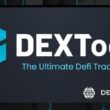Celestia, a groundbreaking project focused on data availability in blockchain, announced the launch of its mainnet on Tuesday. Developed from a 2019 research paper by Mustafa Al-Bassam, the project has made an impressive entrance into the market, with its market capitalization soaring to over $370 million overnight.
A Highly Anticipated Launch
The buildup to Celestia’s mainnet launch had been marked by intense speculation, particularly surrounding its eagerly awaited TIA token airdrop. Considered one of the most highly anticipated giveaways in the crypto industry this year, the substantial interest reflects the project’s ambitious goals to address the underlying issues that currently plague blockchains like Ethereum.
Revolutionizing Data Availability in Blockchain
Celestia sets itself apart by separating data availability from other core functions of blockchain technology. The mainnet introduces a fresh paradigm of modular architecture, greatly enhancing efficiency and scalability. By enabling layer 2 solutions and rollups built on blockchains like Ethereum to store and transmit data on Celestia’s network, it effectively alleviates stress on the base layer blockchain.
At the core of Celestia’s operation lies the groundbreaking technology called Data Availability Sampling (DAS). This innovative approach allows light nodes on the network to confirm data availability through randomized sampling of block data, eliminating the need to download entire data blocks. As more sampling rounds are completed, the effectiveness of this method increases, enabling a node to validate the availability of data once a pre-set confidence level is achieved.
“Celestia’s introduction of modular architecture and Data Availability Sampling presents a significant advancement in the blockchain industry,” says Mustafa Al-Bassam, the project’s founder. Al-Bassam, a highly respected figure in the field, boasts years of research experience and academic collaborations with renowned experts like Ethereum founder Vitalik Buterin.
The TIA token holds a crucial role in ensuring the smooth functioning of Celestia’s services. It serves as a form of payment for developers seeking to store or access data through the network. By charging fees in TIA tokens for data-related transactions, Celestia sustains its unique model, which places a strong emphasis on data availability.
“Celestia’s focus on data availability and modular architecture distinguishes it from competitors like Avail and EigenDA, which offer a broader range of capabilities,” explains Mustafa Al-Bassam.
Recognized for its specialization in data availability services, Celestia marks a departure from its competitors. While rivals like Avail and EigenDA offer more general capabilities, Celestia’s sole dedication to providing data availability sets it apart in the market. This focused approach signifies a growing trend towards tailored modular blockchain networks optimized for specific functions.
With the launch of its mainnet, Celestia presents a possible solution to major challenges such as scalability and interoperability faced by existing blockchain networks. This significant development is the culmination of Mustafa Al-Bassam’s extensive research conducted over the past five years, marking a significant leap in the quest for blockchain modularity.
In conclusion, Celestia’s mainnet launch represents a pivotal moment for the blockchain industry. Its emphasis on data availability and modular architecture holds great potential in addressing key challenges faced by blockchain networks today.
















